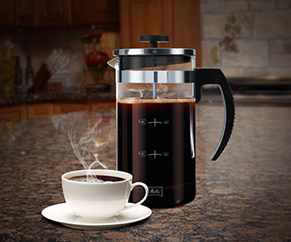Other Coffee Brewers
Espresso Makers
There are many types of espresso makers on the market but in order to brew true espresso, you need to ensure that your machine has a strong pump that can force the water at proper brewing temperatures through finely ground coffee at approximately 9 atmospheres of pressure.
An espresso should take 20-25 seconds to brew in a home espresso machine with a strong pump, and should have the consistency of flowing honey. As the espresso flows into the cup, there should be a caramel-colored foam (“crema”) on top.
Moka Pot
Moka pots are sometimes referred to as a stovetop espresso maker. However, without the pressure of the espresso machine, the coffee brewed in moka pots is closer to that of percolators than espresso makers. There are many variations in design for moka pots but the basic function is the same. At its most basic, the moka pot consists of 3 parts:
A chamber at the bottom for the water. It has a threaded opening for the top section and a pressure relief valve. This section is almost always made from metal and is filled with water to just below the level of the relief valve The middle part holds the ground coffee. It is a metal ring with a funnel attached to its bottom (all one piece). The funnel is separated from the ring by a screen which usually spreads across the bottom of the ring before it narrows for the funnel. This component is also made of metal. This section simply drops into the lower section, and finely ground coffee is spooned in until full or slightly heaping. The grounds should not be packed. The brewed coffee flows into and is poured from the top section which has a threaded opening for the bottom section and is topped off by a lid (commonly one that flips open and closed). This component varies the most, both in shape and composition. The bottom of this section has a screen very similar to the one in the middle section. This screen also leads to a tube, one that points up into the upper section. The upper section gets threaded onto the bottom section, thereby slightly packing the coffee in the middle section. The assembled device is placed on the stove and the water is heated. Since the lower chamber is airtight, the expanding air pushes down on the water and forces it up the lower tube, through the coffee and through the top tube. It spurts out of the tube (which ends near the top of the upper chamber) and drops down into the bottom of the top reservoir. A moka pot can make good quality, strong coffee.
Flip Pots (Napolitano)
These types of stove top coffeemakers are comprised of four metal parts. One part looks like a very small pot with a handle. The second part, which also has a handle, looks like the first but has a spout. These two parts snap together to form the outer part of the coffeemaker. Inside these pieces is a two-piece assembly that looks like a salt shaker. When the internal assembly is removed and its perforated lid unscrewed, a second perforated surface can be seen inside the "saltshaker" about one inch from the lip. Ground coffee is placed inside and the top screwed on.
Water is placed inside the pot-shaped piece and all of the pieces are assembled. The side with the water is placed on a hot stove. When it is hot enough, water will begin to seep out of a tiny hole near the lip of the bottom piece. At this point, you flip the pot over, and the hot water will seep through the coffee into the piece with the spout. Once all the water seeps through (roughly about two minutes), the coffee is ready to be poured. This type of coffeemakers makes a decent strong cup of coffee, but like moka pots and percolators does not filter our bitter oils and sediments.
Vacuum Pot
A funnel-shaped bowl is put on top of a carafe, forming a seal. The funnel's tube leads down into the carafe nearly to the bottom. The top of the tube is covered by one of various designs of filters. Fine grind coffee is placed into this top bowl and then the carafe is placed on a gas stove. As the unit is heated the increased air pressure in the sealed carafe forces the water up the tube into the top bowl where it mixes with the ground coffee. When most of the water has moved to the top portion the heat is reduced and the mixture is allowed to steep for a minute or two.
The device is then removed from the heat source. As the lower bowl cools its internal pressure drops, pulling the liquid down from the upper chamber. The heating container now doubles as the serving carafe. Because of the filter, the grounds remain behind in the top container. This process produces an excellent cup of coffee.
Turkish Coffeemakers (Ibriks)
The Ibrik is filled with water (approximately two-thirds) and very finely powdered coffee (roughly one tablespoon per three ounces of water) is added. The coffee should be evenly distributed on top of the water so the opening is not blocked.
The coffee should be evenly distributed on top of the water so the opening is not blocked. The water should come nearly to a boil in a minute or two and begin to foam up through the coffee. If your coffee boils rather than foams, you may have used too little coffee or over-heated the water. When this foam rises somewhat thickly, remove the pot from the heat long enough for the foam to settle. The grounds should settle in the cup before drinking.






